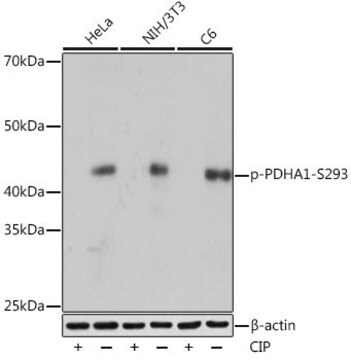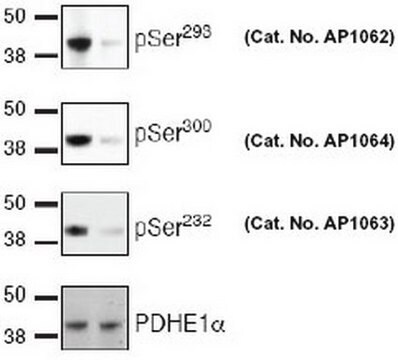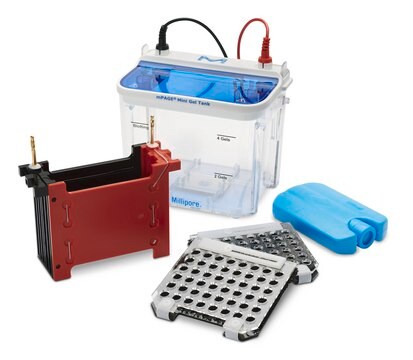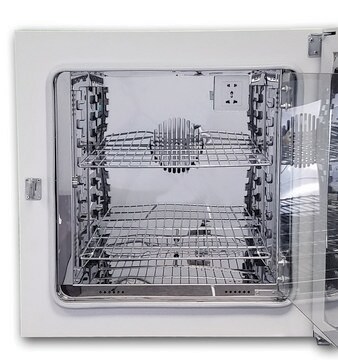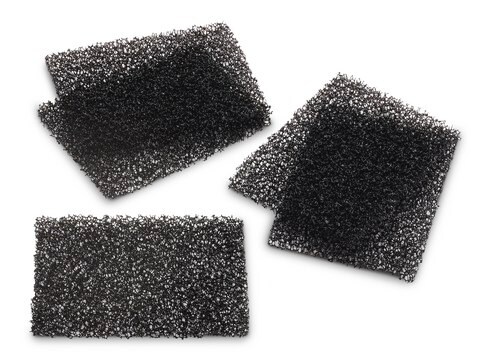ZRB1447
Anti-p-PDHA1-Ser232 Antibody, clone 2D5 ZooMAb® Rabbit Monoclonal

recombinant, expressed in HEK 293 cells
Sinónimos:
Pyruvate dehydrogenase E1 component subunit alpha somatic form mitochondrial;EC:1.2.4.1;PDHE1-A type I
About This Item
Productos recomendados
biological source
rabbit
Quality Level
recombinant
expressed in HEK 293 cells
conjugate
unconjugated
antibody form
purified antibody
antibody product type
primary antibodies
clone
2D5, recombinant monoclonal
description
recombinant, expressed in HEK 293 cells
product line
ZooMAb® learn more
form
lyophilized
mol wt
calculated mol wt 43.3 kDa
observed mol wt ~40 kDa
purified by
using Protein A
species reactivity
human, mouse, rat
species reactivity (predicted by homology)
sheep, horse, bovine, monkey
packaging
antibody small pack of 25 μL
greener alternative product characteristics
Waste Prevention
Designing Safer Chemicals
Design for Energy Efficiency
Learn more about the Principles of Green Chemistry.
enhanced validation
recombinant expression
Learn more about Antibody Enhanced Validation
sustainability
Greener Alternative Product
technique(s)
immunocytochemistry: suitable
immunohistochemistry: suitable
inhibition assay: suitable
western blot: suitable
isotype
IgG
epitope sequence
Internal
Protein ID accession no.
UniProt accession no.
greener alternative category
, Aligned
shipped in
ambient
storage temp.
2-8°C
target post-translational modification
phosphorylation (pSer232)
Gene Information
human ... PDHA1(5160)
General description
Specificity
Immunogen
Application
Evaluated by Western Blotting in Rat liver tissue lysate.
Western Blotting Analysis (WB): A 1:1,000 dilution of this antibody detected PDHA1 phosphorylated on Ser 232 in Rat liver tissue lysate.
Tested applications
Immunohistochemistry (Paraffin) Analysis: A 1:1,000 dilution from a representative lot detected p-PDHA1-Ser232 in Human and Mouse liver tissue sections.
Peptide Inhibition Assay Analysis: Target band detection in Rat liver tissue lysate was prevented by preblocking of a representative lot with the immunogen phosphopeptide, but not the corresponding non-phosphopeptide.
Immunocytochemistry Analysis: A 1:100 dilution from a representative lot detected p-PDHA1-Ser232 in HepG2 cells.
Note: Actual optimal working dilutions must be determined by end user as specimens, and experimental conditions may vary with the end user
Evaluated by Western Blotting in Rat liver tissue lysate.
Western Blotting Analysis (WB): A 1:1,000 dilution of this antibody detected PDHA1 phosphorylated on Ser 232 in Rat liver tissue lysate.
Target description
Physical form
Storage and Stability
Legal Information
Disclaimer
¿No encuentra el producto adecuado?
Pruebe nuestro Herramienta de selección de productos.
Storage Class
11 - Combustible Solids
wgk_germany
WGK 1
flash_point_f
Not applicable
flash_point_c
Not applicable
Elija entre una de las versiones más recientes:
Certificados de análisis (COA)
¿No ve la versión correcta?
Si necesita una versión concreta, puede buscar un certificado específico por el número de lote.
¿Ya tiene este producto?
Encuentre la documentación para los productos que ha comprado recientemente en la Biblioteca de documentos.
Nuestro equipo de científicos tiene experiencia en todas las áreas de investigación: Ciencias de la vida, Ciencia de los materiales, Síntesis química, Cromatografía, Analítica y muchas otras.
Póngase en contacto con el Servicio técnico